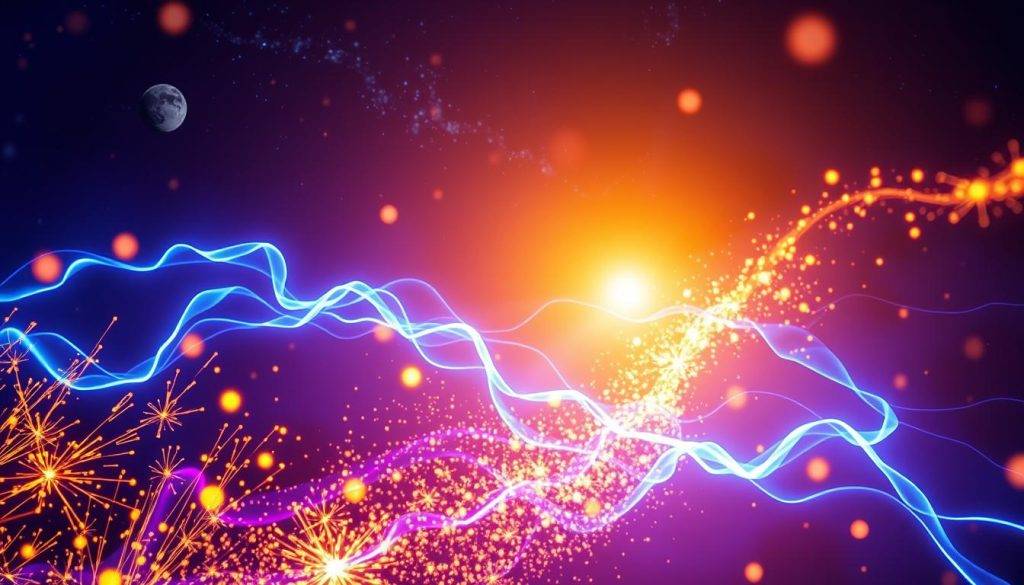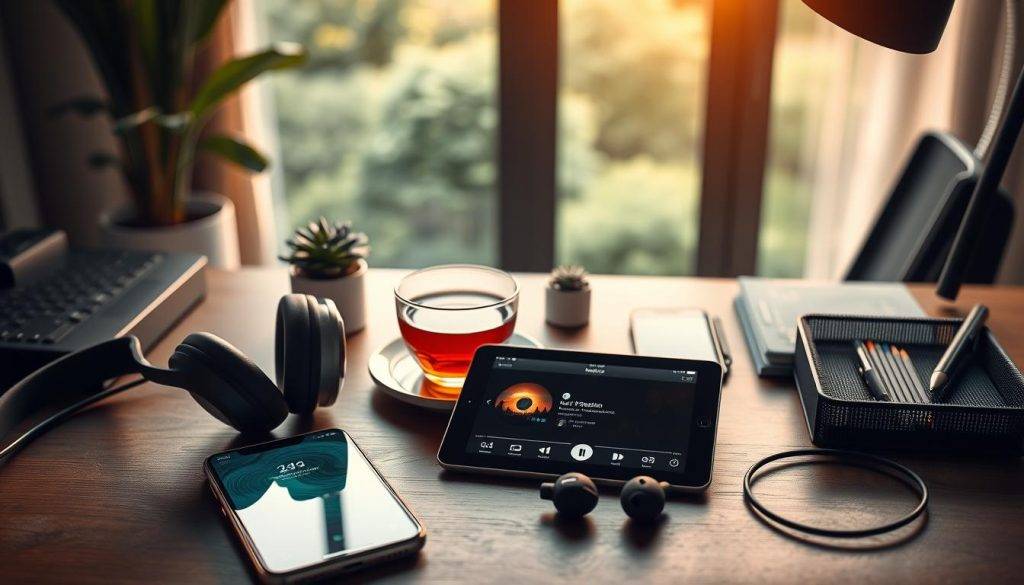“The best moments in our lives are not the passive, receptive, relaxing times… The best moments usually occur when a person’s body or mind is stretched to its limits in a voluntary effort to accomplish something difficult and worthwhile.” — Mihaly Csikszentmihalyi
This short guide shows how science meets practice to help you translate research into daily habits that sharpen focus and trigger a high-performance state for meaningful work and life.
Flow is a learnable condition of deep absorption marked by clear goals, immediate feedback, and the right balance of challenge and skill. Practical steps—minimizing distractions, simple breathwork, and timed work blocks—make the state repeatable.
Readers will get evidence-based strategies to align energy with priority tasks, design an environment that protects cognitive bandwidth, and test small rituals that build momentum. The approach is stepwise, practical, and built for steady gains.
Key Takeaways
- Clear goals + feedback help you enter the flow state more often.
- Reduce distractions with simple environmental tweaks and timers.
- Short breath patterns and movement boost focus and energy.
- Practice one strategy per day; small wins compound into change.
- These tactics apply to creative work, strategy, and daily life tasks.
Why Focus and Flow Matter Right Now
In a world of constant pings, the ability to hold attention over time has become a strategic advantage. Sustained focus improves work quality and raises life satisfaction by allowing deeper, more deliberate effort.
When attention meets a well-matched challenge, people report a clear sense of goals, less self-conscious thought, and faster output. This describes the flow state coined psychologist mihaly Csikszentmihalyi studied — a repeatable condition, not a mystery.
Distractions and anxiety are common barriers. The fastest gains often come from removing friction: control interruptions, structure tasks around your best hours, and protect short blocks of time.
Energy matters. Nutrition, movement, and breathing form the physiological base that lets focus endure. Small shifts in environment and routine compound into better results.

| Barrier | Quick Fix | Benefit |
|---|---|---|
| Notifications | Turn off alerts; use a timer | Longer unbroken attention |
| Unclear goals | Write a one-line outcome | Faster progress and less doubt |
| Low energy | Move briefly; drink water | Stable concentration for tasks |
| Too-large projects | Break into 25–50 minute blocks | More consistent entry into a productive state |
Review weekly: note which activities produced real progress and where distractions crept in. You might find the clearest path to finding flow by first tuning your environment and routines.
The Science of Flow: From Psychologist Mihaly Csikszentmihalyi to Your Daily Routine
When challenge aligns with competence, attention narrows and a deep, rewarding state often follows. Psychologist Mihaly Csikszentmihalyi coined the term to describe an optimal experience marked by intense concentration, intrinsic motivation, and a warped sense of time.

What this mental state feels like
Work may feel effortless; the passage of time blurs. Intrinsic motivation pulls you into the immersed activity and external worries fade.
Triggers: balancing challenge and skill
Clear goals, immediate feedback, and a challenge that fits your skill make tasks engaging rather than overwhelming. Both underload and overload block progress; adjust difficulty in your daily routine to match ability.
Inside the brain
Neuroscience links this state to partial downregulation of the prefrontal cortex. Self-talk quiets, time perception shifts, and creativity can rise. You may feel more control even as difficulty grows because action links directly to outcomes.
- Define the next goal.
- Set a feedback mechanism.
- Pick a task hand level just above comfort.
- Minimize input channels before entering flow state.
Design an Environment Conducive to Deep Concentration
Designing a workspace that quietly supports long stretches of work makes deep concentration more likely. Create a simple, repeatable setup so the environment cues productive behavior and limits friction.

Kill distractions at the source
Turn off notifications, batch email checks, and remove visible clutter. These moves stop low-value interruptions from stealing time and attention.
Set temperature and sound
Productivity rises when ambient temperature sits between 68-77°F; 71°F is often the sweet spot for fewer errors. Tune your thermostat when possible.
Use noise-cancelling headphones to block chatter. Pair them with lyric-less playlists or binaural beats through headphones to keep the auditory channel steady without adding cognitive load.
Lighting, ergonomics, and tools
Diffused light, correct monitor height, and a supportive chair reduce physical strain so concentration lasts longer. Place water nearby and hide snack temptations.
- Keep tools like website blockers and Do Not Disturb modes easy to toggle.
- Set cue-based zones: one surface for deep task work, another for quick admin.
- Run a weekly reset—clear clutter, review what pulled attention, and adjust the setup.
Treat the space as a cockpit. Every element must earn its place by helping you enter and sustain the desired state for focused tasks.
Breathe Into Flow: Practical Techniques to Calm the Mind and Sharpen Focus
Breathing practices offer a quick way to reset arousal and bring attention into a usable state.
Start small. Use short rituals that take two to five minutes so the process fits your schedule while training the body to downshift when needed.

Diaphragmatic breathing
Practice diaphragmatic breaths for 3–5 minutes to increase oxygen uptake and steady heart rate. This lowers arousal, stabilizes energy, and makes sustained concentration easier.
The 4-7-8 reset
The 4-7-8 method—inhale 4, hold 7, exhale 8—calms transitions between hard tasks. One to three cycles clear mental residue so the next block starts cleaner.
Box breathing primer
Box breathing (4-4-4-4) trains rhythm. Repeat for a few minutes to cue the brain that serious work is about to begin, improving capacity for concentration.
Alternate nostril breathing and brief meditation
Two minutes of alternate nostril breathing can rebalance attention before high-stakes work. Pair breathwork with a short meditation—track the inhale and exhale, return gently if the mind wanders.
- Treat breath as a regular practice; short, consistent sessions teach reliable downshifts.
- Use a timer to keep sessions brief—two to five minutes often suffices.
- Log one sentence after each session about what changed; small notes reveal patterns over time.
Activate the Body to Prime the Mind
Short bouts of physical movement prime the nervous system so demanding mental work becomes easier to access. Exercise elevates dopamine and serotonin, improving mood and clarity. Aerobic activity also increases oxygen-rich blood flow to the brain, which supports sustained attention.

Aerobic, strength, and yoga for attention
Use a brisk 5–10 minute walk before a deep session to raise energy and ready systems for work. Rotate brief strength or mobility circuits to spark neurochemical shifts that aid concentration without draining reserves.
Micro breaks to prevent fatigue
University of Illinois research shows short pauses reduce vigilance decrement and performance drops during long tasks. Schedule intentional micro breaks—light mobility, posture resets, or a few yoga poses—so you return refreshed.
- Bookend focus blocks with two minutes of movement.
- Align movement to the task: calming yoga before writing, brisk steps before analysis.
- Capture quick ideas during motion; you might find insights arrive while moving.
Treat movement as a practice. Small, consistent bouts build a reliable on-ramp to a productive flow state and help you feel restored at day’s end.
Structure Your Day for Uninterrupted Focus
Design the day so the hardest work lands in your peak energy windows. Allocate blocks of time for high-cognitive tasks and fill lower-energy spans with routine admin. This simple swap turns variable effort into steady progress.

Time blocking your “golden hours” around peak energy
Identify two or three golden hours and reserve them for your highest-impact tasks. Define one clear goal per block and the exact first step so the task starts without hesitation.
Pomodoro intervals that protect attention
Use Pomodoro-style intervals—25 minutes of work followed by a 3–5 minute break. If an interruption pulls you out, restart the timer to discourage context switching. Short cycles help tasks compound into real progress.
Set boundaries: do not disturb modes and expectations for teammates
“Make your deep work windows visible so others can respect them.”
- Enable Do Not Disturb; silence notifications to reduce distractions.
- Batch messages and schedule meetings together to protect long blocks.
- Begin each interval with a quick breath and end with a stretch to mark transitions.
Treat time blocking as a practice: review your daily routine weekly, split overrunning tasks into smaller task hand–sized pieces, and refine what drives a repeatable state of deep work.
Fuel for Flow: Nutrition, Hydration, and Smart Snacks
What you eat and drink sets the baseline for mental stamina across a long day of tasks. Build meals around complex carbohydrates, quality protein, and healthy fats to deliver steady energy without crashes.

Hydration and simple timing tactics
Keep water visible and sip regularly; even mild dehydration harms concentration and decision quality. Align meal timing with deep work blocks—lighter meals before priority sessions, fuller meals during recovery time.
No-bake snacks to stabilize performance
Prep simple options on Sunday: avocado pesto with raw veggies, cocoa bites, or blueberry bites. Antioxidant-rich berries support memory while healthy fats and protein steady release of fuel during focused activity.
| Nutrient | Benefit | Example |
|---|---|---|
| Complex carbs | Steady glucose for sustained energy | Quinoa, oats, sweet potato |
| Quality protein | Supports neurotransmitters | Greek yogurt, salmon, lentils |
| Healthy fats | Nourish brain structure; smooth fuel release | Avocado, walnuts, flax |
| Antioxidants & B vitamins | Protect neurons; support focus | Blueberries, spinach, eggs |
- Use caffeine wisely: pair with protein or fat for smoother release and avoid late intake that disrupts sleep and next-day state.
- Treat nutrition as a practice—iterate weekly and note what gives the clearest energy and concentration.
- Add a 60–90 second breathing or brief meditation before meals to calm the system and improve digestion.
Good fueling supports both work performance and life outside the office. Small, consistent habits turn nutrition into a dependable part of your routine.
Sharpen Focus and Ignite Flow: A Step-by-Step How-To Protocol
A clear, repeatable routine speeds entry into a deep work state. Start small: set one concrete outcome, tune your space, then use a two-minute breath reset to prime the nervous system.

Pre-work ritual: clear goals, environmental tuning, and a two-minute breath
Set one goal and the first action so the task hand is ready. Close tabs, silence devices, and place tools where you can reach them without thinking.
Use two minutes of diaphragmatic or box breathing to downshift. This simple step turns intent into steady focus.
Entering flow: choose a challenge-matched task and commit for 25–50 minutes
Pick a task that matches skill to challenge. Commit to a single block of 25–50 minutes and avoid switching until the timer ends.
Maintaining momentum: immediate feedback, micro breaks, and energy checks
Track visible progress—checklists, counters, or word counts—so motivation stays high. Take 60–180 second micro breaks to stand, breathe, or stretch and prevent vigilance drops.
Troubleshooting: anxiety, boredom, and distractions in real time
If anxiety rises, reduce scope or break the task into a smaller step. If boredom appears, raise difficulty or add a quick milestone to re-engage the challenge-skill balance.
When distractions arrive, jot them on a capture sheet and return to the process without opening new windows.
Reflect and adjust: track what worked to refine tomorrow’s routine
- Step 1: Define the single goal and first action; clear the space.
- Step 2: Two-minute breath to ready the body.
- Step 3: Entering flow by matching challenge to skill; commit to the timer.
- Step 4: Add immediate feedback and visible progress markers.
- Step 5: Micro breaks to sustain energy across the block.
- Step 6: Troubleshoot quickly—scale scope or raise difficulty as needed.
- Step 7: Capture distractions, then return to the task hand without detours.
- Step 8: Close with a short review of what moved the needle.
- Step 9: Stage the next goal so starting is frictionless.
- Step 10: Repeat daily; over time you may feel entry become faster and more reliable.
Repeat this loop as a daily practice. The process trains the mind to enter the desired state with less setup time and more predictable results.
Tools Like Apps, Playlists, and Headphones That Help You Find Flow
Small, reliable tools reduce setup time and help the mind settle into high-attention activity. This section covers practical tools like blocker-timer apps, noise control, and curated audio that speed entering flow state.

- Pick a blocker-timer combo: apps that restrict distracting sites while running Pomodoro-style intervals simplify deep work logistics.
- Use noise-cancelling headphones to shape your acoustic environment, then play instrumental or ambient playlists to reduce verbal interference during demanding activity.
- Experiment with binaural beats at low volume using quality headphones; some people report faster entry into a steady flow state.
- Create a one-tap Do Not Disturb shortcut and pair timers with visual progress bars to make starting a protected block quick and consistent.
- Keep a lightweight “focus toolkit” folder—apps, favorite playlists, and a short checklist—so the process of setup becomes automatic.
“Tools should serve the process; if a tool adds friction, remove it.”
Test one change at a time and log results. Revisit your setup monthly to prune redundancies and refresh playlists so the tools continue to help you find flow without becoming another distraction.
Conclusion
A consistent set of small rituals, environmental tweaks, and brief resets makes sustained attention a practical skill. ,
Find flow by aligning clear goals with a matched challenge, adding immediate feedback, and protecting a quiet space. Use short breathwork or a two-minute meditation before a scheduled 50-minute block to prime the mind.
Remove friction—fewer distractions, faster starts, steady nutrition, hydration, and movement—and the state arrives more often. Track what worked, run a monthly reset, and prune tools that add noise.
Rooted in the work of the coined psychologist, these strategies turn an abstract idea into a repeatable daily routine that helps you finish meaningful tasks with calm confidence.
FAQ
What is a flow state and who coined the term?
Psychologist Mihaly Csikszentmihalyi coined the term “flow.” It describes a mental state of deep immersion where intrinsic motivation, a sense of timelessness, and high performance align. People often feel fully absorbed in the task at hand with reduced self-talk and heightened creativity.
How can someone tell they are entering flow?
Early signs include effortless concentration, distortion of time, loss of self-consciousness, and clear focus on immediate goals. Physical cues can be steady breathing, relaxed posture, and fewer distractions grabbing attention.
What role do challenge and skill play in achieving flow?
Flow requires a balance: tasks should match skill level and present clear goals with immediate feedback. Too easy leads to boredom; too hard triggers anxiety. Calibrating the challenge keeps motivation and engagement high.
Which environmental changes most reliably support deep concentration?
Remove distractions by turning off notifications and decluttering the workspace. Use noise-cancelling headphones or lyric-less ambient music, set comfortable lighting and ergonomics, and aim for a steady temperature around 71°F for many people.
What breathing practices help prepare the mind for deep work?
Try diaphragmatic breathing to stabilize energy, the 4-7-8 technique to reset between tasks, box breathing as a primer before focused sessions, and alternate nostril breathing combined with brief mindfulness to enter flow faster.
How does physical activity affect concentration and flow?
Aerobic exercise, strength work, and yoga raise neurotransmitters like dopamine and support sustained focus. Short micro breaks with movement prevent vigilance decrement and reduce mental fatigue during long tasks.
How should someone structure their day to protect concentrated work time?
Time block high-value “golden hours” around peak energy, use Pomodoro intervals to reduce context switching, and set clear do-not-disturb boundaries with teammates and devices to preserve uninterrupted attention.
What nutrition and hydration habits support cognitive performance?
Favor complex carbs, quality protein, and healthy fats to sustain energy. Stay hydrated to avoid attention dips and choose antioxidant-rich, no-bake snacks that provide steady fuel without crashes.
What is a simple protocol to enter and maintain flow during a work session?
Begin with a pre-work ritual: set a clear goal, tune your environment, and do a two-minute breath. Choose a challenge-matched task and commit for 25–50 minutes, use immediate feedback and micro breaks to maintain momentum, and track results to refine the next session.
Which tools reliably help people find flow?
Focus apps that block distractions, timers for deep work, curated ambient playlists, binaural beats, and quality noise-cancelling headphones are common aids. Choose tools that minimize interruptions and match personal preference.
How should someone troubleshoot obstacles like anxiety, boredom, or interruptions?
For anxiety, downregulate with breathwork and simplify goals. For boredom, increase challenge or change tasks. For interruptions, set explicit boundaries, use focus apps, and communicate availability to teammates to reduce context switching.
Can meditation and mindfulness improve one’s ability to enter flow?
Yes. Regular meditation trains attention control and reduces intrusive self-talk, making it easier to enter sustained concentration states. Short mindfulness practices before work accelerate the transition into deep focus.
How long does it usually take to develop a reliable flow routine?
Building dependable habits varies, but consistent daily practice—small rituals, environmental tuning, and tracking—produces measurable improvement in weeks. Refinement continues as one logs experiences and adjusts strategies.




























































